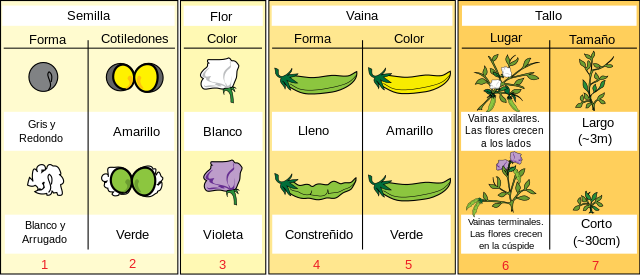Throughout history, relationships between prominent scientists have sometimes been anything but frictionless. This is exactly what happened with the two founding fathers of modern Biology, Mendel and Darwin. Although today we link Darwin with evolution, and Mendel with genetic inheritance, Darwin tried to clarify the mysteries of inheritance, while Mendel studied evolutionary phenomena. And it is this intersection between their lines of research where some disagreements emerged. Clarifying what happened is not only of historic, but also of scientific interest, as it can shed some light about what is it that makes some theories prevail while others are criminally overlooked.
Mendel and evolution
Darwin published “On The Origin of Species” in 1858. Mendel read the second German edition of Darwin’s work in 1863 and published “Experiments on Plant Hybrids” in 18661. In this work he detailed his hybridization experiments involving pea plants and other plant species based on which he developed his theories about how plants inherit traits, and tried to explain how these mechanisms were, in some way or another, linked to evolution. Thus, in the introductory paragraphs he included a sentence defending detailed experiments, such as the ones he had conducted, seemed to be “the one correct way of finally reaching a solution to a question whose significance for the evolutionary history of organic forms cannot be underestimated.” And throughout the rest of his text he used time and again terms like “evolved” or “evolutionary development”. In this sense, it is worth noting that, in the last chapter of the book Concluding Remarks he wrote: “This circumstance is especially important for the evolutionary history of plants because constant hybrids acquire the status of new species”.

We can therefore say that Mendel embraced the tenets of Darwinian evolution. However, this did not preclude him from challenging some of the evolutionary premises set forth by the great English naturalist. Specifically, in several instances throughout his book he questioned Darwin’s idea that plant growing conditions can increase the appearance of inheritable variations (on which natural selection would subsequently act). This idea was central to Darwin’s theory in that he tried, by analogy, to juxtapose this concept to explain what happens in nature when conditions of life change. Mendel, at the end of the penultimate chapter of Darwin’s work, correctly contested such assertions, and wrote that such variability occurs: “according to a determined law that finds its formula in the combination of several independent factors” making reference here to “their factors” which control the variability of organisms, and which are reshuffled as different varieties are grown and cross-bred.
Darwin and inheritance
As we mentioned above, Darwin published in 1858 his theory that living creatures are the result of selective processes that have acted on the hereditary variations that have emerged throughout our planet’s history. But at the time, as he himself acknowledged in “On the Origin of Species”, Darwin did not have a clear idea about how such variations were inherited. In fact, in the first chapter he wrote: “The laws governing inheritance are for the most part unknown.”
That is why he continued focusing and researching on the topic of inheritance. So much so that ten years later, in 1868, he published “The Variation of Animals and Plants under Domestication”, an extensive work that included a chapter – the 27th – entitled “The provisional hypothesis of Pangenesis,” where he proposed a hypothetical mechanism for heredity. According to his hypotheses, every organ and tissue of living creatures emits gemmules, minuscule particles containing trait information, which travel through the circulatory stream to the reproductive organs and tissues. After fertilization, both parents’ gemmules combine and interact, and this interaction determines the blend of parent traits inherited by the different components of offsrpring.
In stark contrast, two years before, Mendel had concluded that inheritance is determined by the existence of certain “factors” (what we now know as genes) in reproductive cells that are passed from parents to offspring without mixing, meaning that the factors behind traits are passed independently.

Darwin did not cite Mendel’s experiments and conclusions in his hypothesis. It has been said that Mendel sent him a reprint of his article. But no such document has ever been found in his files. So we will never know what were Darwin’s thoughts about Mendel’s experiments and findings about inheritance, or about his objections regarding the origin of these variations. But we do have evidence about Mendel’s views on Darwin’s pangenesis theory. And they were not very favorable.
Mendel’s (unfavorable and accurate) views about Darwin’s inheritance hypothesis
Mendel set forth his views and objections to Darwin’s pangenesis hypothesis – which he himself dubbed “provisional” – in a series of ten letters he sent to renowned Swiss botanist Nägeli, and also in the many annotations he wrote on the aforementioned chapter 27 of his copy of Darwin’s book on Variation.
Mendel wrote down and underlined passages in that chapter in which Darwin himself recognized that the existence of free gemmules was a “gratuitous assumption” and that, as a hypothesis, it was a classic example of “inductive-descriptive” science. In contrast, Mendel approach was hypothetical-deductive and experiment-based; and one with, more importantly, mathematical rigor3. As for Darwin’s lack of mathematical rigor, Mendel underlined a passage in which Darwin mentioned the results of a series of experiments involving the crossing of many white and yellow-flowered species of Verbascum, noting that the offspring never blended, but bore either pure white or pure yellow blossoms, “the former in the larger proportion”, without going into any further analysis. Had he counted them, Darwin would have observed that they were close to a typically Mendelian 3:1 ratio.
Or, also in connection with Darwin’s ideas about inheritance being mere inductive-descriptive hypotheses, Mendel conducted experiments to prove the validity of the English naturalist’s assertion that males contributed more gemmule to offspring than females – which meant that, in order to take place, fertilization required many grains of pollen. Mendel had fertilized four o’clock plants by hand with single grains of pollen, proving that it was enough to produce seed. And so he told Nägeli in one of his letters. But Nägeli, who also corresponded with Darwin at close to the same time as he did with Mendel, never communicated this information to the distinguished Englishman. Nor did he inform him about Mendel’s hypothesis on inheritance. Perhaps all this was because Nägeli seemed to believe that Mendel’s theories were based on his observations involving a limited number of plant species, which required confirmation with other specimens. But Mendel had problems doing this because the species that Nägeli proposed for further investigation, Hieracium, much like dandelion, has a strange reproductive system, combining sexual and asexual reproduction.

Mendel’s thoughts about Darwin’s pangenesis theory were made unmistakably clear on the handwritten note he included right after a passage from chapter 27, describing how gemmules travelled to the reproductive organs, and which read: “to indulge in an impression without reflection”.
Therefore, after this historical-conceptual analysis of the relationship between two of pivotal figures in Biology, whose pioneering works laid the foundations of modern biology, it is clear that Mendel accepted Darwin’s ideas about evolution, but with reservations. However, while Darwin’s evolutionary theory “succeed”, his ideas about inheritance “failed”. And Mendel “succeeded” in this line of research – although his work was not recognized until the turn of the 20th century – because, perhaps for the first time, he applied the hypothetical-deductive method experimentally in Biological research, using mathematical tools, which is what, according to his observations, Darwin’s inheritance hypotheses lacked.
Learn more
-
Free versions of Mendel’s “Experiments on Plant Hybrids“ can be easily found online.a Also, “On the Origin of Species” and “Variation of Animals and Plants under Domestication” can be read in English at Darwin online. There are several printed versions of these works in Spanish.
-
There is abundant bibliography analyzing the relationship between Mendel and Darwin. All of it has been collected, updated and expanded in a recent article by D.J. Fairbanks. Heredity, 2019-20. Mendel and Darwin: Untangling a Persistant Enigma. 124: 263-273
-
Ruiz Rejón: Mendel, a Paradigmatic Scientist
Comments on this publication